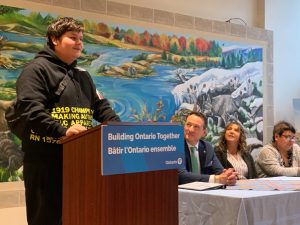June 2021
Context: The Vitality and Potential of the GTA’s Urban Indigenous Community
The devastating impacts of COVID-19 are well known: countless job losses and business closures against the backdrop of the human toll taken by the virus itself. It should come as no surprise that recovering from the pandemic will take just as much collective effort as fighting the virus. The pandemic revealed deep cracks within the economy where certain groups were harder hit by both the health and economic harms of the virus. Governments are now beginning to turn their focus to policies and programs that will help Canadians and Canadian businesses recover from the pandemic. Recovery plans must include specific policies and initiatives that help those that were hardest hit by the pandemic to come out even stronger, better supported and prepared to fully participate and thrive in the recovery to come.
Canada is not achieving its full economic and social potential as a country whenever any individual, or group, is left behind in the economy. Canada’s full economic and social potential is realized when two necessary conditions are in place. The first condition is that businesses are creating jobs and economic opportunities so that anyone who wants to work, has work. But job creation alone is not a sufficient condition for achieving potential. The second condition is that anyone who wants to work has access to the skills training that empowers them to find work that is meaningful to them, dignified, and stable.
The Greater Toronto Area (GTA) is home to Canada’s largest Urban Indigenous community. By some estimates, there are currently 55,000-70,000 Indigenous people living in Toronto alone, which is double the current official estimate.1 In fact, 85.5% of Indigenous people in Ontario live in cities and towns, not on reserves as is the popular belief. Urban Indigenous people are often undercounted in official statistics like the Census which results in these communities often being overlooked by government policymakers – and they are often some of the hardest hit communities in times of economic hardship.
The challenges facing off-reserve Indigenous communities during economic downturns are well documented. In the Great Recession of 2008-2009, off-reserve Indigenous people felt the impacts of the recession longer, and their recovery was slower than non-Indigenous people.2 The pandemic-related impacts of the current recession are shaping up to be very similar to those of the Great Recession with off-reserve Indigenous people seeing more drastic decreases in employment compared to non- Indigenous people.3 For instance, while Indigenous and non-Indigenous people initially experienced similar declines in employment levels (approximately a 1-2% decrease in employment each month from March-June) due to COVID-19, 10 months into the pandemic, Indigenous people were experiencing comparatively worse employment outcomes than non-Indigenous people. In addition, just under 40% of Indigenous people surveyed have reported that the pandemic has made it difficult for them to meet their financial obligations, compared to a quarter of non-Indigenous people in the same survey. While some may not find these data compelling, it is important to remember that Indigenous Canadians, particularly Urban Indigenous Canadians, generally experience higher levels of unemployment, underemployment, and lower labour force participation during non-pandemic times.
The economic and social playing field was not close to even between Indigenous and non-Indigenous communities going into COVID-19. This reality means that government policy makers cannot build recovery policies and programs that inherently assume everyone went into the COVID-19 economic recession with similar circumstances. There needs to be differentiation and specific solutions to help the GTA’s Urban Indigenous come back better and stronger from COVID-19. That is what this paper is about. It is about solutions that provide the GTA’s Urban Indigenous community with the skills development and employment supports to give them greater agency in the economy to find meaningful work that is dignified and stable. This paper is about hope tethered to realistic and practical steps that governments and Urban Indigenous organizations like Miziwe Biik Aboriginal Employment and Training (Miziwe Biik) can take together to heal the economic and social harm of COVID-19 and continue on the journey of Truth and Reconciliation between Indigenous and non-Indigenous communities in Canada.
Miziwe Biik has been an innovator at the forefront of supporting the economic and social ambitions of the GTA’s Urban Indigenous community for 30 years. Miziwe Biik has been designing and delivering culturally relevant education and job training programming that is responsive to labour market needs and leads to positive employment outcomes for its clients. The organization understands the specific employment barriers faced by the GTA’s Urban Indigenous community and how to overcome them so that the full potential of this
growing community can be achieved. To support governments of all stripes in preparing their plan for economic recovery, Miziwe Biik is putting forward specific and actionable recommendations to ensure that Urban Indigenous people are full participants in the GTA’s and Ontario’s economic renaissance. These recommendations are about more than “returning to normal” post-COVID, they are about a new set of impactful institutions and programs that are set toward the aim of making the Urban Indigenous community full and equal partners in the GTA’s economic and social success.
Read the entire report.

